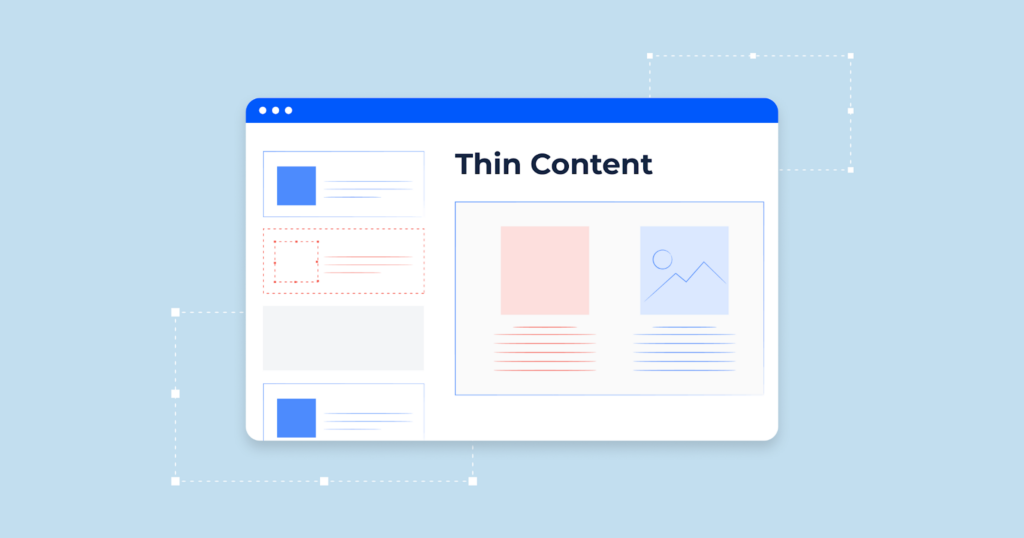What is Thin Content & How to Fix it Fast?

Thin content refers to pages on a website that offer little value to visitors. Often these pages have insufficient word counts, provide no unique information, or fail to adequately cover their topics.
For websites and blogs trying to rank well in search engines, thin content can severely impact efforts. Fortunately, by understanding what causes thin content, and learning repair strategies, you can dramatically improve your site. Let’s explore some easy steps that’ll help you fix thin content quickly.
Understanding Thin Content
Thin content lacks useful information and value for readers. Some common causes of thin pages include:
Low Word Counts
Pages with less than 300 words are often considered thin content. Search engines want to see in-depth, comprehensive coverage of topics. Pages with only a brief paragraph fail to demonstrate expertise or fully inform visitors.
Repurposed Content
Republishing existing content from other sites without adding original perspectives or commentary results in repetitive, low-value pages. Simply rewriting content or paraphrasing still fails to offer anything new to audiences.
Affiliate Focused
Pages solely dedicated to promoting affiliate offers or products often lack substantive information around a topic. They focus more on conversions rather than providing advice and education through detailed content.
Irrelevant Pages
Sometimes sites create pages to increase site linkage, backlinks, or advertising space without considering actual value for visitors. These pages seem tangential or unnecessary for the rest of the site’s core content.
Poor Expertise
Pages short on details, research, resources, or accurate information demonstrate limited mastery of topics to search engines. Well-researched, credible content is a signal of expertise.
The effects of thin pages add up over time across larger sites. Having over optimized, repetitive, or low-quality content triggers issues.
The Negative Effects of Thin Content on SEO
Thin or low-value content has definite consequences when it comes to search engine optimization and marketing. Two of the most prominent include:
Search Engine Penalties
One risk facing websites with extensive thin content includes manual or algorithmic actions from search engines like Google. Penalties typically involve loss of rankings, traffic limitations, or even removals from the index.
Some of the possible penalties tied to low-quality, thin pages include:
- Panda Update – Targets sites with little unique value on pages using filters and rankings adjustments.
- Thin Content Penalty – Identifies pages with insufficient word counts or value and limits visibility.
- Duplicate Content Penalty – Punishes sites republishing existing content across the web via filtering and downgrading.
- Page Layout Algorithm Update – Assesses webpage quality including thin content and decreases impressions.
- Manual Spam Actions – Reviewers can manually label sites with thin affiliate pages as spam leading to deindexing.
While penalties originate from different algorithms and processes, they universally target sites over optimized with repetitive or irreverent content rather than informative, useful pages.
Impact on Website Rankings
Beyond specific penalties, thin content also fails to accumulate signals used in search rankings. Pages lacking in-depth coverage struggle to gain links, engagement, and authority around topics useful for clicks and conversions.
Contrast this with content that offers true value through education and emotional connections with readers. Compelling pages drive social media sharing, links, time on site and other engagement metrics vitally important within ranking formulas.
Effective Strategies to Address Thin Content
The most effective approach entails four key strategies to rapidly improve thin content issues:
Perform a Website Audit
The first step focuses on fully documenting thin content through a detailed content audit examining page word counts, topics, engagement and performance indicators.
Sort pages by key factors like word counts under 300 words, duplicate content percentage, affiliate links versus editorial content, etc. This creates a snapshot identifying the website’s thinnest areas in need of improvement. Ongoing audits also track changes over time.
Identify Pages with Thin Content
The audit naturally highlights the website’s thinnest pages suffering from insufficient word counts or reliance on affiliate-based content. Typically blogs and websites find anywhere from 20% to 40% of pages underperform due to thin content once formally audited.
Documenting the titles and urls pinpoints what pages should undergo removal or revisions moving forward through exportable spreadsheets. Having clarity on poor pages gives direction for what to improve.
Improve or Remove Thin Content
With specific thin pages now framed from the audit, website owners have two options- improve or remove subpar pages.
Improving content involves expanding more useful, engaging details for visitors while deleting allows focusing efforts instead on new pages rich in value. Building upon themes and topics with the highest potential typically works best based on monitoring updated metrics from search engine consoles.
Some specific ways to improve existing content includes expanding details around recommendations, addressing visitor questions within the industry, compiling related resources, incorporating additional media like videos or graphics and spending time better optimizing pages for aligned keyword groupings. Improving ten pages a month continues driving progress.
Another highly effective solution to improve thin website content utilizes artificial intelligence tools like PopAi. Websites can rapidly expand current thin pages by producing new original paragraphs and even full articles using an ai writing software. These articles are optimized specifically around improving page word counts, uniqueness and keyword targeting for better search visibility and visitor engagement.
For removing pages with limited potential, redirecting URLs to other related site pages preserves some link equity and site authority gradually accumulated over time. Although starting fresh works too.
Implement Technical SEO Best Practices
With updated content fueling organic growth, websites should additionally adapt technical SEO fundamentals which complement content.
This includes site speed optimizations, structured data additions, url semantics improvements, and internal linking expansions connecting new pages. Technical and content-based efforts combined lead to more visible transformations month over month.
Conclusion
Thin content poses not only problems with search visibility but also underdelivers for visitor engagement critical for conversions. By identifying thin content through audits, targeting specific pages for improvement or removal and layering-in technical SEO website best practices, websites can position better content for user satisfaction and search engine results visibility boosts.


